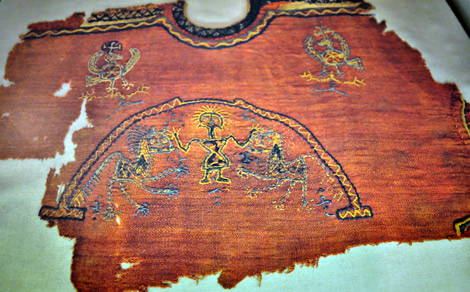Montserrat’s Museum brings its Coptic textiles to light

Montserrat’s Museum presents, until Nov. 2nd, an unprecedented exhibition of Coptic textiles. It is the completion of a long process of work, study and restoration, which started after they were donated to the Monastery in 1999 by Soler Vilabella family.
The exhibition ‘The Coptic Textiles of Montserrat’s Museum: The Soler Vilabella collection’ has worth beyond the textile typologies it gathers. Its importance lies especially in all the historiography that contextualizes the origin of the materials.
It also confirms Catalonia’s importance in the sphere of textile collecting at the beginning of the 20th century, when great European collectors and museums would rival to get some of the great textiles from Egypt’s Coptic necropolis’ excavations.
The exhibition’s structure, whose curator is Lluís Turell, is a journey through the collection’s history, from Albert Gayet’s excavations in Antinoë between 1898 and 1914, until the donation to Montserrat’s Museum, its study and subsequent restoration by the Institut de Patrimoni Cultural d’Espanya, finished in 2012.
A three-area exhibition
The first area reconstructs –by means of the original correspondence- the relationship between Ramon Soler Vilabella and the French archaeologist Albert Gayet: the first letter, where we can sense Vilabella’s interest for the textiles found by Gayet in Egypt –they had delighted everyone at Paris’s International Exhibition in 1900-; the money orders to bear the expenses of part of Gayet’s archaeological campaigns; The testament of Marie Gayet –sister of the famous archaeologist- certifying that great part of these textiles –they never reached Soler Vilabella- belonged to her/him.
The second area is a selection of the most significant materials of the collection, classified into clothing textiles, like tunics or shawls, and furniture textiles –tablecloths or curtains-, all of them from 4th to 8th centuries A. D. The importance of most of the artefacts lies in their size and conservation status, as well as their direct connection with the funerary world of that period, since they were all part of the clothing of the deceased.
Finally, the third area explains the whole process of restoration carried out by the IPCE (Spanish Cultural Heritage Institute): suction, cleaning, consolidation and reconstruction, complemented by chromatography tests, thin layer and X-ray techniques, carbon dating, etc. Parallel to this, Lluís Turell made historiographic, typological and chronological essays for his dissertation, directed by the University of Barcelona, and integrated in a R&D project from Universidad Complutense de Madrid.
Activities on the Coptic textiles
In parallel with the exhibition, Montserrat’s Museum (MDM) has programmed several activities suitable for all audiences, mainly lecture cycles. There will be one lecture per month between April and November. Sessions will focus on several topics related to textiles and clothing in the ancient world. Archaeologist Lluís Turell –curator of the exhibition- is giving the first talk on April 12th. This talk is focusing in the importance of the Soler Vilabella’s Coptic textiles’ collection of Montserrat’s Museum.
The MDM has also organized a series of workshops for children, where they will be able to discover the different fabrics present in these textiles, while practising textile dyeing just like it was in that period of history. Finally, the MDM will offer guided tours to go deep into the contents of the exhibition.

